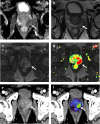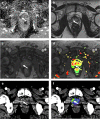4D perfusion CT of prostate cancer for image-guided radiotherapy planning: A proof of concept study
- PMID: 31856177
- PMCID: PMC6922381
- DOI: 10.1371/journal.pone.0225673
4D perfusion CT of prostate cancer for image-guided radiotherapy planning: A proof of concept study
Abstract
Purpose: Advanced forms of prostate cancer (PCa) radiotherapy with either external beam therapy or brachytherapy delivery techniques aim for a focal boost and thus require accurate lesion localization and lesion segmentation for subsequent treatment planning. This study prospectively evaluated dynamic contrast-enhanced computed tomography (DCE-CT) for the detection of prostate cancer lesions in the peripheral zone (PZ) using qualitative and quantitative image analysis compared to multiparametric magnet resonance imaging (mpMRI) of the prostate.
Methods: With local ethics committee approval, 14 patients (mean age, 67 years; range, 57-78 years; PSA, mean 8.1 ng/ml; range, 3.5-26.0) underwent DCE-CT, as well as mpMRI of the prostate, including standard T2, diffusion-weighted imaging (DWI), and DCE-MRI sequences followed by transrectal in-bore MRI-guided prostate biopsy. Maximum intensity projections (MIP) and DCE-CT perfusion parameters (CTP) were compared between healthy and malignant tissue. Two radiologists independently rated image quality and the tumor lesion delineation quality of PCa using a five-point ordinal scale. MIP and CTP were compared using visual grading characteristics (VGC) and receiver operating characteristics (ROC)/area under the curve (AUC) analysis.
Results: The PCa detection rate ranged between 57 to 79% for the two readers for DCE-CT and was 92% for DCE-MRI. DCE-CT perfusion parameters in PCa tissue in the PZ were significantly different compared to regular prostate tissue and benign lesions. Image quality and lesion visibility were comparable between DCE-CT and DCE-MRI (VGC: AUC 0.612 and 0.651, p>0.05).
Conclusion: Our preliminary results suggest that it is feasible to use DCE-CT for identification and visualization, and subsequent segmentation for focal radiotherapy approaches to PCa.
Conflict of interest statement
The authors have declared that no competing interests exist.
Figures




References
-
- Chopra S, Toi A, Taback N, Evans A, Haider MA, et al. (2012) Pathological predictors for site of local recurrence after radiotherapy for prostate cancer. International Journal of Radiation Oncology* Biology* Physics 82: e441–e448. - PubMed
-
- Monninkhof EM, van Loon JW, van Vulpen M, Kerkmeijer LG, Pos FJ, et al. (2018) Standard whole prostate gland radiotherapy with and without lesion boost in prostate cancer: Toxicity in the FLAME randomized controlled trial. Radiotherapy and Oncology 127: 74–80. 10.1016/j.radonc.2017.12.022 - DOI - PubMed
Publication types
MeSH terms
Substances
Associated data
LinkOut - more resources
Full Text Sources
Medical
Research Materials
Miscellaneous

